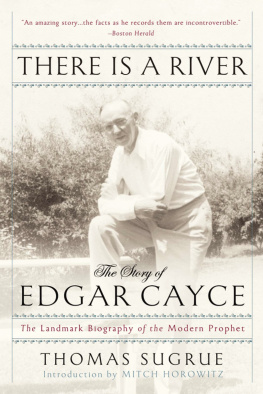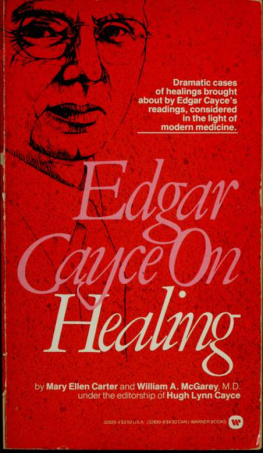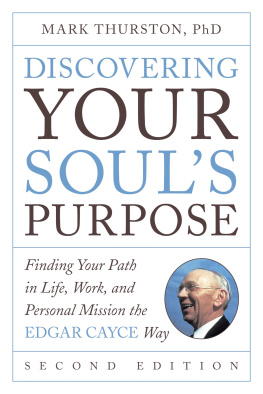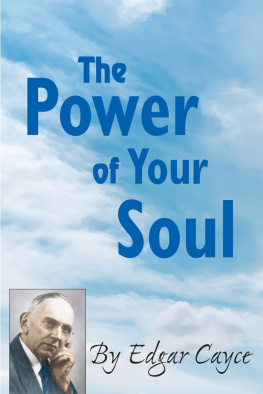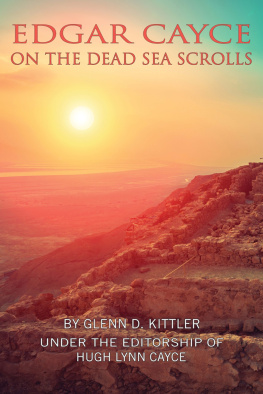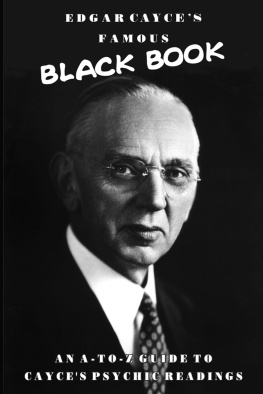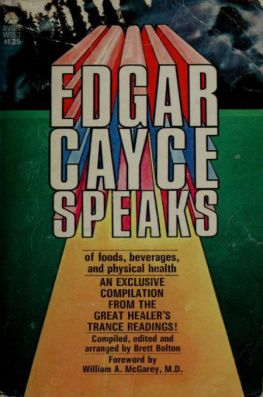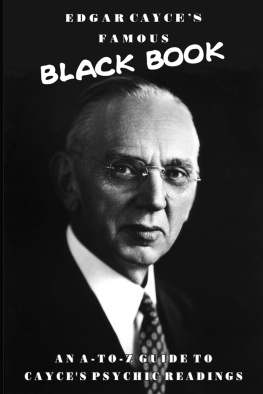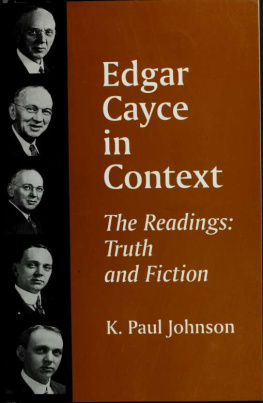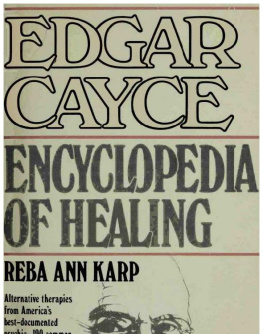
Jeremy P. Tarcher/Penguin
Published by the Penguin Group
Penguin Group (USA) LLC
375 Hudson Street
New York, New York 10014

USA Canada UK Ireland Australia New Zealand India South Africa China
penguin.com
A Penguin Random House Company
Copyright 1942, 1945 by Holt, Rinehart and Winston
Renewal 1970 by Mary Ganey Sugrue, 1973 by Patricia Sugrue Channon
Originally published by Henry Holt and Company, Inc., in 1942 and revised in 1945
Published by arrangement with Patricia S. Ketchum
First Jeremy P. Tarcher/Penguin edition 2015
Introduction copyright 2015 by Mitch Horowitz
Edgar Cayce Readings 1971, 1993, 1994, 1995, 1996 by the Edgar Cayce Foundation
Penguin supports copyright. Copyright fuels creativity, encourages diverse voices, promotes free speech, and creates a vibrant culture. Thank you for buying an authorized edition of this book and for complying with copyright laws by not reproducing, scanning, or distributing any part of it in any form without permission. You are supporting writers and allowing Penguin to continue to publish books for every reader.
Most Tarcher/Penguin books are available at special quantity discounts for bulk purchase for sales promotions, premiums, fund-raising, and educational needs. Special books or book excerpts also can be created to fit specific needs. For details, write: Special.Markets@us.penguingroup.com.
ISBN 978-0-698-18196-0
Neither the publisher nor the author is engaged in rendering professional advice or services to the individual reader. The ideas, procedures, and suggestions contained in this book are not intended as a substitute for consulting with your physician. All matters regarding your health require medical supervision. Neither the author nor the publisher shall be liable or responsible for any loss or damage allegedly arising from any information or suggestion in this book.
Version_1
CONTENTS

There is a river,
the streams whereof shall make glad the city of God....
PSALMS 46:4
INTRODUCTION

Edgar Cayce: Ordinary Man, Extraordinary Messenger
BY MITCH HOROWITZ
T he year 1910 marked a turning point in Western spirituality. It saw the deaths of some of the most luminous religious thinkers of the nineteenth century, including psychologist-seeker William James; popular medium Andrew Jackson Davis; and Christian Science founder Mary Baker Eddy. These three figures deeply impacted the movements in positive thinking, prayer healing, and psychical research.
Their death that year was accompanied by the rise to prominence of a new religious innovatora figure who built upon the spiritual experiments of the nineteenth century to shape the New Age culture of the dawning era. In autumn of 1910, TheNew York Times brought the first major national attention to the name of Edgar Cayce, a young man who later became known as the father of holistic medicine and the founding voice of alternative spirituality.
The Sunday Times of October 9, 1910, profiled the Christian mystic and medical clairvoyant in an extensive article and photo spread: Illiterate Man Becomes a Doctor When Hypnotized. At the time, Cayce (pronounced Casey), then thirty-three, was struggling to make his way as a commercial photographer in his hometown of Hopkinsville, Kentucky, while delivering daily trance-based medical readings in which he would diagnose and prescribe natural cures for the illnesses of people he had never met.
Cayces method was to recline on a sofa or daybed; loosen his tie, belt, cuffs, and shoelaces; and enter a sleeplike trance; then, given only the name and location of a subject, the sleeping prophet was said to gain insight into the persons body and psychology. By the time of his death in January 1945, Cayce had amassed a record of more than 14,300 clairvoyant readings for people across the nation, with many of the sessions captured by stenographer Gladys Davis.
In the 1920s, Cayces trance readings expanded beyond medicine (which nonetheless remained at the core of his work) to include life readings, in which he explored a persons inner conflicts and needs. In these sessions, Cayce employed references to astrology, karma, reincarnation, and number symbolism. Other times, he expounded on global prophecies, climate or geological changes, and the lost history of mythical cultures, such as Atlantis and Lemuria. Cayce had no recollection of any of this when he awoke, though as a devout Christian the esotericism of such material made him wince when he read the transcripts.
Contrary to news coverage, Cayce was not illiterate, but neither was he well educated. Although he taught Sunday school at his Disciples of Christ churchand read through the King James Bible at least once every yearhe had never made it past the eighth grade of a rural schoolhouse. While his knowledge of Scripture was encyclopedic, Cayces reading tastes were otherwise limited. Aside from spending a few on-and-off years in Texas, unsuccessfully trying to use his psychical abilities to strike oilhe had hoped to raise money to open a hospital based on his clairvoyant curesCayce rarely ventured beyond the Bible Belt environs of his childhood.
Since the tale of Jonah fleeing from the word of God, prophets have been characterized as reluctant, ordinary folk plucked from reasonably satisfying lives to embark on missions that they never originally sought. In this sense, if the impending New Agethe vast culture of Eastern, esoteric, and therapeutic spirituality that exploded on the national scene in the 1960s and 1970swas seeking a founding prophet, Cayce could hardly be viewed as an unusual choice, but, historically, as a perfect one.
A SEER IN SEASON
It was this Edgar Caycean everyday man, dedicated Christian, and uneasy mysticwhom New England college student and future biographer Thomas Sugrue encountered in 1927. When Sugrue met Cayce, the twenty-year-old journalism student was not someone who frequented psychics or sance parlors. Sugrue was a dedicated Catholic who had considered joining the priesthood. Deeply versed in world affairs and possessed of an iron determination to break into news reporting, Sugrue left his native Connecticut in 1926 for Washington and Lee University in Lexington, Virginia, which was then one of the only schools in the nation to offer a journalism degree to undergraduates. (Sugrue later switched his major to English literature, in which he earned both bachelors and masters degrees in four years.)
As a student, Sugrue rolled his eyes at paranormal claims or talk of ESP. Yet Sugrue met a new friend at Washington and Lee who challenged his preconceptions: the psychics eldest son, Hugh Lynn Cayce. Hugh Lynn had planned to attend Columbia but his fathers clairvoyant readings directed him instead to the old-line Virginia school. (The institution counted George Washington as an early benefactor.) Sugrue grew intrigued by his new friends stories about his fatherin particular the elder Cayces theory that one persons subconscious mind could communicate with anothers. The two freshmen enjoyed sparring intellectually and soon became roommates. While still cautious, Sugrue wanted to meet the agrarian seer.

